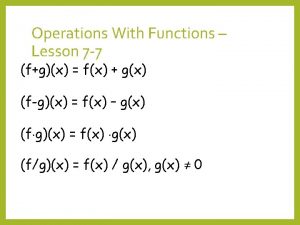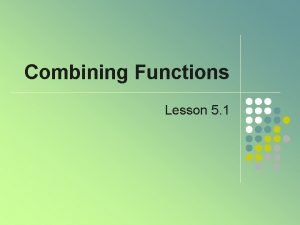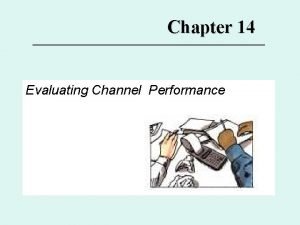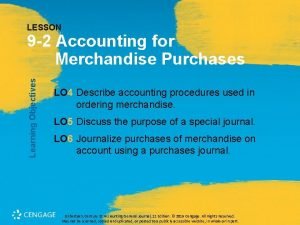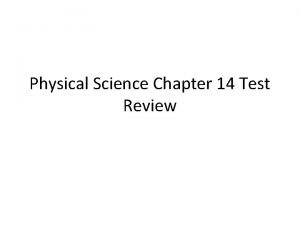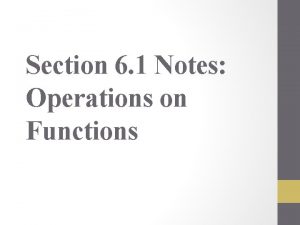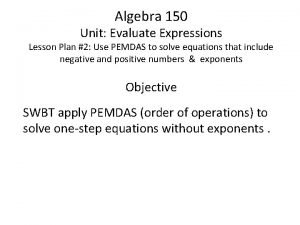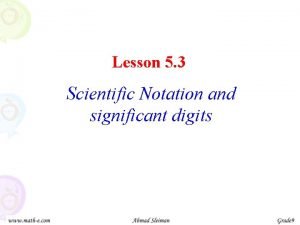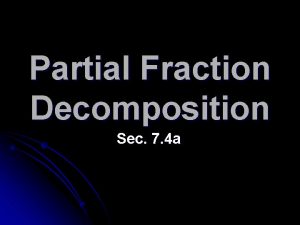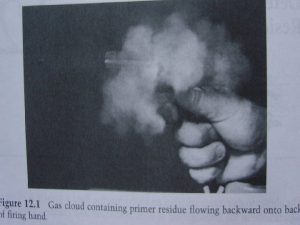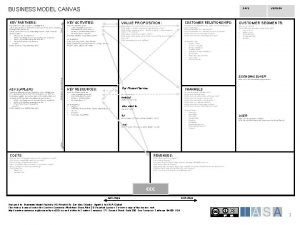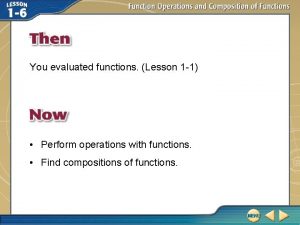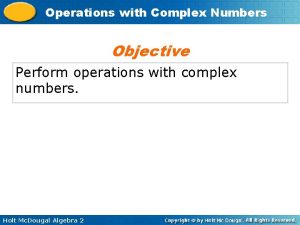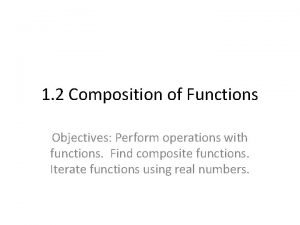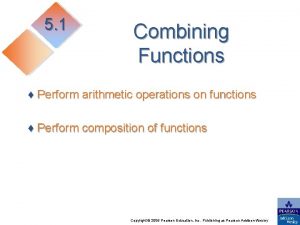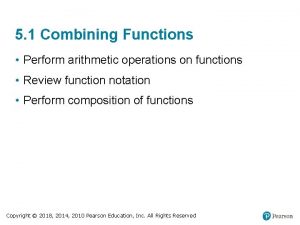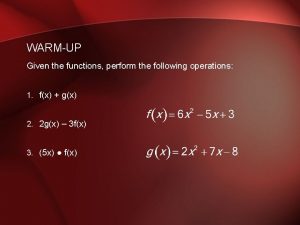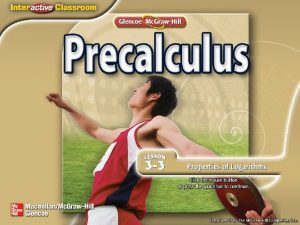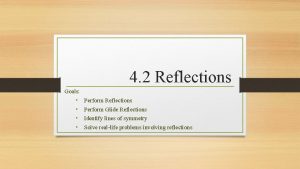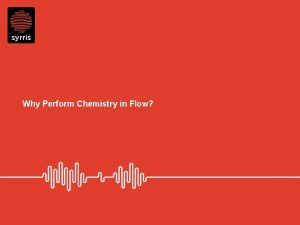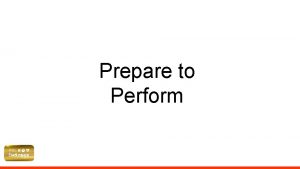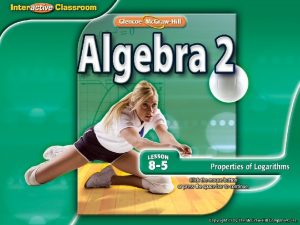You evaluated functions Lesson 1 1 Perform operations


















![Find a Composite Function with a Restricted Domain Answer: for (–∞, 0] [2, ∞). Find a Composite Function with a Restricted Domain Answer: for (–∞, 0] [2, ∞).](https://slidetodoc.com/presentation_image/ff1cb93ce5a897edba000b721a7f29b7/image-19.jpg)


















- Slides: 37

You evaluated functions. (Lesson 1 -1) • Perform operations with functions. • Find compositions of functions.

• composition


Operations with Functions A. Given f (x) = x 2 – 2 x, g (x) = 3 x – 4, and h (x) = – 2 x 2 + 1, find the function and domain for (f + g)(x) = f(x) + g(x) Definition of sum of two functions = (x 2 – 2 x) + (3 x – 4) f (x) = x 2 – 2 x; g (x) = 3 x – 4 = x 2 + x – 4 Simplify. The domain of f and g are both so the domain of (f + g) is Answer:

Operations with Functions B. Given f (x) = x 2 – 2 x, g (x) = 3 x – 4, and h (x) = – 2 x 2 + 1, find the function and domain for (f – h)(x) = f(x) – h(x) Definition of difference of two functions = (x 2 – 2 x) – (– 2 x 2 + 1) f(x) = x 2 – 2 x; h(x) = – 2 x 2 + 1 = 3 x 2 – 2 x – 1 The domain of f and h are both of (f – h) is Answer: Simplify. so the domain

Operations with Functions C. Given f (x) = x 2 – 2 x, g(x) = 3 x – 4, and h (x) = – 2 x 2 + 1, find the function and domain for (f ● g)(x) = f (x) ● g(x) Definition of product of two functions = (x 2 – 2 x)(3 x – 4) f (x) = x 2 – 2 x; g (x) = 3 x – 4 = 3 x 3 – 10 x 2 + 8 x Simplify. The domain of f and g are both of (f ● g) is Answer: so the domain

Operations with Functions D. Given f (x) = x 2 – 2 x, g (x) = 3 x – 4, and h (x) = – 2 x 2 + 1, find the function and domain for Definition of quotient of two functions f(x) = x 2 – 2 x; h(x) = – 2 x 2 + 1

Operations with Functions The domains of h and f are both (–∞, ∞), but x = 0 or x = 2 yields a zero in the denominator of domain of Answer: . So, the (–∞, 0) (0, 2) (2, ∞). D = (–∞, 0) (0, 2) (2, ∞)

Find (f + g)(x), (f – g)(x), (f ● g)(x), and for f (x) = x 2 + x, g (x) = x – 3. State the domain of each new function.

A. B. C. D.


Compose Two Functions A. Given f (x) = 2 x 2 – 1 and g (x) = x + 3, find [f ○ g](x). = f (x + 3) Replace g (x) with x + 3 = 2(x + 3)2 – 1 Substitute x + 3 for x in f (x). = 2(x 2 + 6 x + 9) – 1 Expand (x +3)2 = 2 x 2 + 12 x + 17 Simplify. Answer: [f ○ g](x) = 2 x 2 + 12 x + 17

Compose Two Functions B. Given f (x) = 2 x 2 – 1 and g (x) = x + 3, find [g ○ f](x). Answer: = (2 x 2 – 1) + 3 Substitute 2 x 2 – 1 for x in g (x). = 2 x 2 + 2 Simplify [g ○ f](x) = 2 x 2 + 2

Compose Two Functions C. Given f (x) = 2 x 2 – 1 and g (x) = x + 3, find [f ○ g](2). Evaluate the expression you wrote in part A for x = 2. [f ○ g](2) = 2(2)2 + 12(2) + 17 = 49 Answer: [f ○ g](2) = 49 Substitute 2 for x. Simplify.

Find and g (x) = 4 + x 2. A. 2 x 2 + 11; 4 x 2 – 12 x + 13; 23 B. 2 x 2 + 11; 4 x 2 – 12 x + 5; 23 C. 2 x 2 + 5; 4 x 2 – 12 x + 5; 23 D. 2 x 2 + 5; 4 x 2 – 12 x + 13; 23 for f (x) = 2 x – 3

Find a Composite Function with a Restricted Domain A. Find .

Find a Composite Function with a Restricted Domain To find , you must first be able to find g(x) = (x – 1) 2, which can be done for all real numbers. Then you must be able to evaluate for each of these g (x)-values, which can only be done when g (x) > 1. Excluding from the domain those values for which 0 < (x – 1) 2 <1, namely when 0 < x < 1, the domain of f ○ g is (–∞, 0] [2, ∞). Now find [f ○ g](x).

Find a Composite Function with a Restricted Domain Replace g (x) with (x – 1)2. Substitute (x – 1)2 for x in f (x). Simplify. Notice that is not defined for 0 < x < 2. Because the implied domain is the same as the domain determined by considering the domains of f and g, we can write the composition as for (–∞, 0] [2, ∞).
![Find a Composite Function with a Restricted Domain Answer for 0 2 Find a Composite Function with a Restricted Domain Answer: for (–∞, 0] [2, ∞).](https://slidetodoc.com/presentation_image/ff1cb93ce5a897edba000b721a7f29b7/image-19.jpg)
Find a Composite Function with a Restricted Domain Answer: for (–∞, 0] [2, ∞).

Find a Composite Function with a Restricted Domain B. Find f ○ g.

Find a Composite Function with a Restricted Domain To find f ○ g, you must first be able to find , which can be done for all real numbers x such that x 2 1. Then you must be able to evaluate for each of these g (x)-values, which can only be done when g (x) 0. Excluding from the domain those values for which 0 > x 2 – 1, namely when – 1 < x < 1, the domain of f ○ g is (–∞, – 1) (1, ∞). Now find [f ○ g](x).

Find a Composite Function with a Restricted Domain

Find a Composite Function with a Restricted Domain Answer:

Find a Composite Function with a Restricted Domain Check Use a graphing calculator to check this result. Enter the function as . The graph appears to have asymptotes at x = – 1 and x = 1. Use the TRACE feature to help determine that the domain of the composite function does not include any values in the interval [– 1, 1].

Find a Composite Function with a Restricted Domain


Decompose a Composite Function A. Find two functions f and g such that when . Neither function may be the identity function f (x) = x.

Decompose a Composite Function h Sample answer:

Decompose a Composite Function B. Find two functions f and g such that when h (x) = 3 x 2 – 12 x + 12. Neither function may be the identity function f (x) = x. h (x) = 3 x 2 – 12 x + 12 Notice that h is factorable. = 3(x 2 – 4 x + 4) or 3(x – 2) 2 Factor. One way to write h (x) as a composition is to let f (x) = 3 x 2 and g (x) = x – 2.

Decompose a Composite Function Sample answer: g (x) = x – 2 and f (x) = 3 x 2


Compose Real-World Functions A. COMPUTER ANIMATION An animator starts with an image of a circle with a radius of 25 pixels. The animator then increases the radius by 10 pixels per second. Find functions to model the data. The length r of the radius increases at a rate of 10 pixels per second, so R(t) = 25 + 10 t, where t is the time in seconds and t 0. The area of the circle is times the square of the radius. So, the area of the circle is A(R) = R 2. So, the functions are R(t) = 25 + 10 t and A(R) = R 2. Answer: R(t) = 25 + 10 t; A(R) = R 2

Compose Real-World Functions B. COMPUTER ANIMATION An animator starts with an image of a circle with a radius of 25 pixels. The animator then increases the radius by 10 pixels per second. Find A ○ R. What does the function represent? A ○ R = A[R(t)] Definition of A ○ R =A(25 + 10 t) Replace R (t) with 25 + 10 t. = (25 + 10 t)2 Substitute (25 + 10 t) for R in A(R). = 100 t 2 + 500 t + 625 Simplify.

Compose Real-World Functions So, A ○ R = 100 t 2 + 500 t + 625. The composite function models the area of the circle as a function of time. Answer: A ○ R = 100 t 2 + 500 t + 625 ; the function models the area of the circle as a function of time.

Compose Real-World Functions C. COMPUTER ANIMATION An animator starts with an image of a circle with a radius of 25 pixels. The animator then increases the radius by 10 pixels per second. How long does it take for the circle to quadruple its original size? The initial area of the circle is ● 25 2 = 625 pixels. The circle will be four times its original size when [A ◦ R ](t) = 100 t 2 + 500 t + 625 = 4(625 ) = 2500. Solve for t to find that t = 2. 5 or – 7. 5 seconds. Because a negative t-value is not part of the domain of R (t), it is also not part of the domain of the composite function. The area will quadruple after 2. 5 seconds. Answer: 2. 5 seconds

BUSINESS A satellite television company offers a 20% discount on the installation of any satellite television system. The company also advertises $50 in coupons for the cost of equipment. Find [c ◦ d](x) and [d ◦ c](x). Which composition of the coupon and discount results in the lower price? Explain. A. [c ◦ d](x) = 0. 80 x – 40; [d ◦ c](x) = 0. 80 x – 50; Sample answer: [d ◦ c](x) represents the cost of installation using the coupon and then the discount results in the lower cost. B. [c ◦ d](x) = 0. 80 x – 40; [d ◦ c](x) = 0. 80 x – 50; Sample answer: [c ◦ d](x) represents the cost of installation using the discount and then the coupon results in the lower cost. C. [c ◦ d](x) = 0. 80 x – 50; [d ◦ c](x) = 0. 80 x – 40; Sample answer: [c ◦ d](x) represents the cost of installation using the discount and then the coupon results in the lower cost. D. [c ◦ d](x) = 0. 80 x – 50; [d ◦ c](x) = 0. 80 x – 40; Sample answer: [c ◦ d](x) represents the cost of installation using the coupon and then the discount results in the lower cost.

 Perform the indicated operation. (see objectives 1 and 2.)
Perform the indicated operation. (see objectives 1 and 2.) Evaluating functions and operations on functions
Evaluating functions and operations on functions Evaluating functions and operations on functions
Evaluating functions and operations on functions Function operations definition
Function operations definition Lesson 5-1 operations with functions
Lesson 5-1 operations with functions Function composition and operations lesson 5-1
Function composition and operations lesson 5-1 Ready to be evaluated pqeb
Ready to be evaluated pqeb Small business subcontracting is only evaluated when
Small business subcontracting is only evaluated when Small business participation commitment document
Small business participation commitment document An evaluating criteria for channel members.
An evaluating criteria for channel members. 13. a form requesting the purchase of merchandise.
13. a form requesting the purchase of merchandise. Chapter 6 organizational behavior
Chapter 6 organizational behavior Chapter 14 review physical science
Chapter 14 review physical science Examples of operation management
Examples of operation management Operations management functions
Operations management functions 6-1 operations on functions
6-1 operations on functions Order of operations lesson plan
Order of operations lesson plan Operations and scientific notation lesson 5
Operations and scientific notation lesson 5 You say you love rain
You say you love rain You are what you eat do you agree or disagree
You are what you eat do you agree or disagree If you think you can you can poem
If you think you can you can poem Tell me what you eat and i shall tell you what you are
Tell me what you eat and i shall tell you what you are Wherever you go we follow
Wherever you go we follow Absolute value function to piecewise function
Absolute value function to piecewise function Wced core values
Wced core values Rinne test
Rinne test 113-com-1022 perform voice communications
113-com-1022 perform voice communications Perform voice communications army
Perform voice communications army Decompose into partial fractions
Decompose into partial fractions Neogov perform
Neogov perform Ghusl mayyit
Ghusl mayyit Exploritory robots
Exploritory robots Paraffin test procedure
Paraffin test procedure Who perform a smartly dressed parade
Who perform a smartly dressed parade Perform on commit vs update task
Perform on commit vs update task Haltenberger steering system
Haltenberger steering system Key suppliers business model canvas
Key suppliers business model canvas Form storm norm perform
Form storm norm perform




